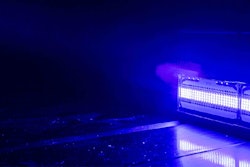Ongoing pest management inspections are required in food processing facilities. In fact, other than documentation, proper visual inspections is the only other skill needed in all segments of the food plant pest management program. Before the control plan is established, detailed inspections are required to form risk assessment and are part of the monitoring, corrective action and verification process.
Pest management inspections rely heavily on the ability to see pests and conditions favorable to pests. There are a variety of tools which can be used to increase the inspector’s view. Evolving technology is also positively contributing to inspection capabilities. Some tools an inspector can never do without, and some tools will be required based on special circumstances.
Pest management professionals and food plant staff need to be educated and trained on proper inspection tools needed as part of the pest management program. There are a variety of tools, that when properly used, can increase the inspector’s ability to see pests and evidence of a pest infestation. Below are a few of these visual tools and aids needed for a complete pest management inspection.
- Flashlight: As indicated, in order to perform a visual inspection, you have to see into areas of pest activity. There really is no excuse for not having a flashlight during a building inspection. Interior building light quality will vary and in some areas, inspectors will need a flashlight just to navigate the space for safety reasons. Pests will often be located in secluded areas and lighting those areas will be critical in finding and identifying the activity. The introduction of LED technology to the flashlight market allows inspectors to carry extremely bright lights and even in some cases, too bright a light for inspection. It is best to have a flashlight that allows the inspector to adjust light brightness and focus. The flashlight should also have a relatively long battery life or charge to allow the inspector to complete the inspection with the assistance of a reliable light. One technique that can be used to increase the ability to see insect trails, small insects and rodent tracks, is to hold the flashlight on an angle to the surface to help see shadows and movement.
- Magnifier: LED technology has also improved the ability to see insects under magnification. There are some relatively inexpensive LED light assisted magnifiers on the market for use in confirming pest identification. The addition of the light makes it much easier to see the magnified insects.
- Vials or Other Containers for Capturing Specimens: It can be helpful to capture the insect or other pest evidence like fecal pellets for further identification if a field ID cannot be performed. Vials should be made from plastic with a screw top.
- Camera: Although some facilities may restrict picture taking, especially for contractors, a picture can be invaluable in showing the pest activity found and conditions supporting pest activity. Photos can be useful in training staff and helping staff fix conditions by pinpointing the inspector’s observations. A photo will illustrate the severity of a problem better than words alone and can lead to quicker corrective actions. For close up shots of pests, various clip on magnifiers are available as cell phone attachments to capture images of pests which are small in size. Another camera phone attachment, the selfie stick, may be used to extend the camera reach and be able to view areas above and beyond view. The telescoping pole can be used to access difficult to reach areas and the phone angle to capture the view.
- Notebook: Although a camera can provide a visual recording of what was observed, in most cases, a notebook will be needed for note taking and recording observations.
- Spatula: Some of the secluded pest harborages may need to be disturbed through the use of a spatula to uncover pest activity. An angled spatula similar to what is used for applying cake frosting is recommended. These are available with plastic handles suitable for food processing areas. The angle on the spatula makes it easier to insert the spatula blade underneath equipment like the bases of storage racks, equipment legs and into floor expansion cracks.
- Sticky Traps Including Pheromone Traps: An insect monitoring device can provide eyes in an area 24/7. An inspector will only be present a few hours but a well-placed and secured trap will be there around the clock. Traps can provide a snap shot of current conditions and trends over time.
- Multi-tool: Occasionally inspectors will need to remove an equipment cover, pull up a drain grate or cut open shrink wrap to access an insect or pest evidence. An all-in-one multi-tool can help reduce the need to carry different pieces of equipment while allowing inspectors the ability to open up areas for further detailed inspection.
- Telescoping Metal Inspection Mirror: Stainless steel mirrors are available which can be angled to view above, below and around corners for an increased view of hard to see areas.
- Pheromone Lures: Wearing a stored product pest lure during the inspection can help bring insects to the inspector. Beware, the lures have a tendency to remain on clothing, skin and personal items and stored product pests may continue to follow you after work.
- Fiber Optic Scopes: These devices are used to see into structural and equipment voids. They can be a time saver allowing inspectors to look into equipment without having to disassemble the equipment. These tools permit the viewing of structural voids or equipment voids which cannot be opened. Small drill holes can be made to walls to view the interior for signs of pests through the fiber optic extension. As with many technological devices, these cameras have become very affordable using cell phones as viewing screens. Price ranges can run from under $100 to over $1,000.
- Online Satellite Images: Services which provide a satellite image of the site can be useful in determining pest pressures from neighboring properties. Identifying areas of pest vulnerability can help direct inspection efforts. It is well documented that insects will follow lines, even for navigation purposes during flight. Therefore, observing roadways and creek paths in the facilities direction through satellite imagery can help visualize potential pest flight paths and determine important exterior lines of defense.
- Moisture Meters: A moisture meter can be very useful in finding sources of moisture which may link to pest infestations. They are not necessarily a tool to be used every day but can be handy to have available when trying to determine a source of pest supporting moisture.
- Infrared Cameras: Just like the fiber optic scopes, these cameras have become very affordable when a cell phone is used as the viewing screen. They can be useful in finding sources of heat, and moisture relating to pest activity. The more expensive the camera, the better the quality and definition of image. Infrared cameras can be used in detecting pests such as rats, honey bees and carpenter ants in wall voids.
An inspection can help uncover the root causes of pest problems and help unveil the conditions which can lead to future pest problems. An inquisitive mind and knowledge of pest biology, identification and behavior will also be needed. A good inspector will take advantage of the many tools available in enhancing their visual, analysis, and pest knowledge skills.
About the author
Patricia Hottel is technical director at McCloud Services and has over 35 years of pest management industry experience. Hottel is a board-certified entomologist and a member of the National Pest Management Association’s Commercial and Fumigation Committees. She is also a former member of the board of directors of the National Pest Management Association (NPMA) and the Illinois Pest Control Association (IPCA). She has served on the board of directors for the professional pest management fraternity, Pi Chi Omega, is a past chair and current member of the Copesan Technical Committee, is a past chair of NPMA’s exam review board, and the NPMA Technical Committee. Hottel holds a bachelor’s degree in entomology from the University of Georgia and a master’s degree in instructional technology from the University of Central Missouri.






















